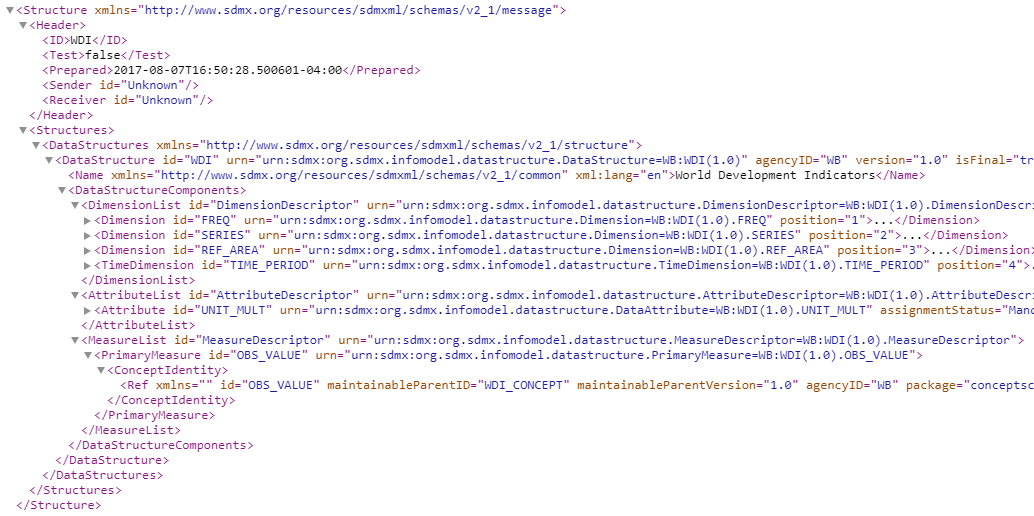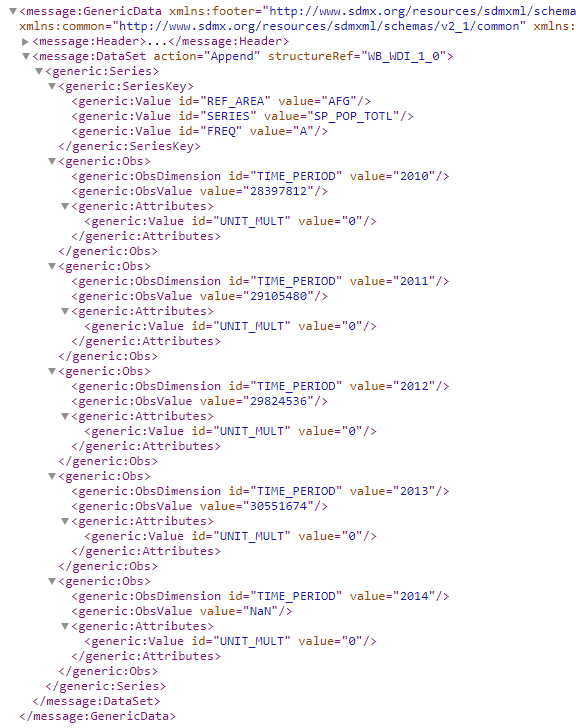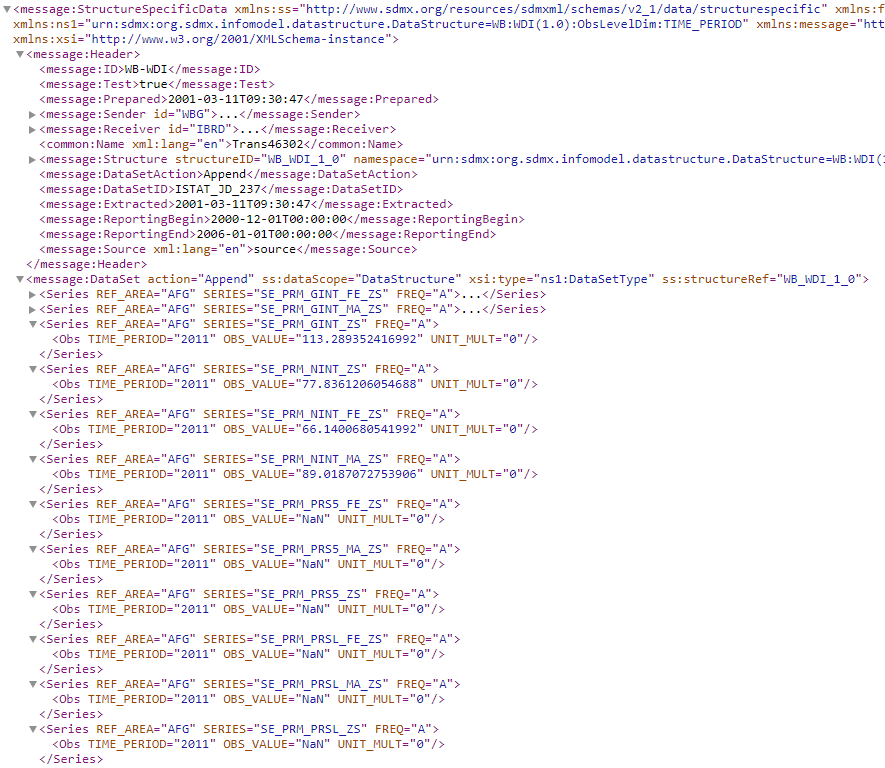SDMX API Queries
Use the SDMX REST API to programmatically access databases that are available in Databank. At present the World Development Indicators (WDI) dataset is available through API, and we are planning to add more datasets soon. If you are interested having SDMX access to a specific dataset currently available in Databank, please let us know by email at data@worldbank.org.
In the SDMX API, users can give various dimensions as a parameter in the URL like series code, country code, or frequency and time range etc., and the resulting data can be downloaded as XML or JSON.
World development Indicators (WDI)
World Development Indicators (WDI) is the primary World Bank collection of development indicators, compiled from officially recognized international sources. It presents the most current and accurate global development data available, and includes national, regional and global estimates. WDI data can be downloaded by specifying values for the dimensions below:
Series
Series code. Refer to the WDI DSD for a list of series names and codes.
Country
ISO Country code.
Time
Specify a single year or range of years.
Limitation on Data Request
In order to avoid server overload, requests for the entire database are not possible in one query. Data calls are restricted to 15,000 data points per call including null values.
Basic Call structure
There are two types of request - one request type is to retrieve the metadata, and the other is to retrieve data. The following SDMX response formats are supported in this API.
SDMX-ML 2.1 generic schema:
This is the default format. Please note that generic format output size will be greater when compared to other formats.
SDMX-ML 2.1 structure specific schema:
The structure specific schema is more suited for processing of large data. To get responses in this format, modify the HTTP request header field Accept: application/vnd.sdmx.structurespecificdata+xml on the SDMX data query request.
JSON Format:
To get the data in JSON format, modify the HTTP request header field Accept: application/vnd.sdmx.data+json;version=1.0.0-wd on the SDMX data query request.
Metadata request
This section explains the call to get DataFlow, Code List and DSD.
Data Flow
This end-point retrieves the unique dataset code for World Bank datasets.
-
URL:
-
Method:
GET
-
URL Parameter:
None
-
Response Format:
XML
-
Success Response:
HTTP Response Status Code: 200
Content: The response has the data flow code to access the World Bank datasets
-
Sample request and Output
- URL:
https://api.worldbank.org/v2/sdmx/rest/dataflow
- Response

Code List
This endpoint retrieves the code list for the WDI dataset.
-
URL:
-
Method:
GET
-
URL Parameter:
None
-
Response Format:
XML
-
Success Response:
HTTP Response Status Code: 200 Content: The response has the code list available for various dimension in WDI dataset. -
Sample request and Output
-
Response:

Data Structure Definition (DSD)
This API retrieves the Data Structure Definition (DSD) for the WDI dataset
-
URL:
-
Method:
GET
-
URL Parameter:
None
-
Response Format:
XML
-
Success Response:
HTTP Response Status Code: 200 Content: The response has the Data Structure Definition (DSD) for WDI dataset -
Sample request and Output
- URL
https://api.worldbank.org/v2/sdmx/rest/datastructure/wb
- Response

-
Error Response:
The following error response is returned for invalid parameter value.
HTTP Response Status Code: 404 Content: Invalid structure code
Data Request
Data calls are used to download data in Generic, Compact and JSON format. Users can request data for a country and series over a period, however data points in a single query cannot exceed more than 15,000 data points.
In data calls, the dimensions are separated by . dot as shown below
-
URL:
http://api.worldbank.org/v2/sdmx/rest/data/<dataset%20id>/../?startperiod=&endPeriod=
-
Method:
GET
-
URL Parameter:
-
Dataset id: Dataset id, for example, “WDI”
-
Freq: The possible value for frequency is “A”. If no value is specified, it is considered as all frequencies.
-
Series: Series code. Refer WDI DSD for list of series names and codes.
-
Country: ISO Country code.
-
StartPeriod: This is a year parameter and can have values from 1960 onwards. If ignored, data for all available years will be returned.
-
EndPeriod: This is a year parameter and can have values from 1960 onwards. If ignored, all data available from the start period to the latest available years will be returned.
-
-
Response Format:
XML- SDMX-ML 2.1 generic schema, XML- SDMX-ML 2.1 structure specific schema or JSON
-
Success Response:
HTTP Response Status Code: 200 Content: The response has the following information. - Series - Country - Time
Sample Request:
To request one country, one series and one year:
<https://api.worldbank.org/v2/sdmx/rest/data/WDI/A.SP_POP_TOTL.AFG/?startperiod=2011&endPeriod=2011>
To request all countries, one series and one year:
<https://api.worldbank.org/v2/sdmx/rest/data/WDI/A.SP_POP_TOTL./?startperiod=2011&endPeriod=2011>
To request all series, one country and one year:
<https://api.worldbank.org/v2/sdmx/rest/data/WDI/A..AFG/?startperiod=2011&endPeriod=2011>
To request one country, one series and a range of years:
<https://api.worldbank.org/v2/sdmx/rest/data/WDI/A.SP_POP_TOTL.AFG/?startperiod=2010&endPeriod=2015>
Sample Response Format:
SDMX-ML 2.1 generic schema

SDMX-ML 2.1 structure specific schema

JSON Format

The response contains the result value of the Country, Series, Time and Frequency combination. If any of the dimensions are not specified in the request URL, all the data related to that dimension will be retrieved in relation to the other dimensions.
Error Response:


